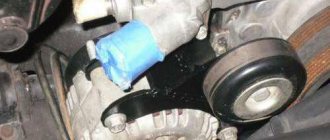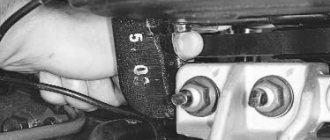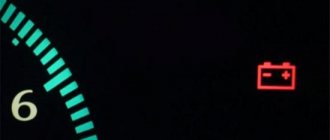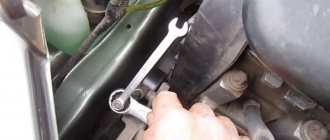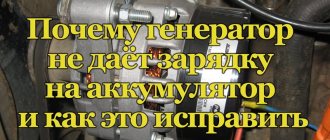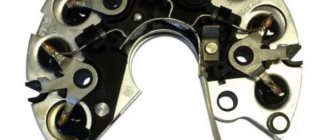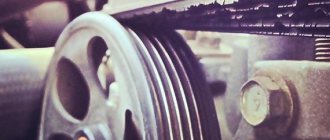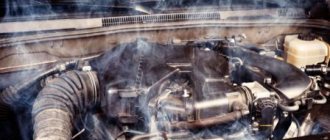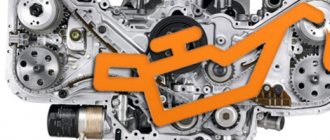07/18/2021 64 174 Engine
Author: Ivan Baranov
Many drivers, due to their carelessness, may miss the moment of replacing the alternator belt and, as a result, it may break. This happens rarely, but it does happen. What should you do if you don’t have a replacement drive at hand, but you need to somehow get to your home or service station? What could be the consequences? This situation is undesirable, but not critical.
In order to decide what to do in this situation, you need to know what this node is intended for and how it functions. It’s not difficult and every car enthusiast should have an idea, even the most superficial one.
[Hide]
How can you tell if the alternator belt is broken?
You can determine that the alternator belt has broken by the following signs:
- The low battery icon appears on the control panel. This indicator lights up because the generator unit or battery is not functioning properly.
- Malfunctions of external lighting devices. If the driver takes his foot off the gas pedal, the headlights begin to shine dimmer; when the gas is pressed, the brightness of the optical instruments is restored.
What to do when the tension weakens?
When the belt loosens, you need to tighten the tension rollers with a wrench. Since the generator unit is equipped with several rollers, each of them allows you to set the desired degree of tension. However, full tension to the stop is not recommended, as this will lead to faster wear of the product.
What happens when a belt breaks?
If the drive belt breaks, the user may encounter the following problems:
- The generator set will not be able to power the vehicle's electrical system, including all equipment and appliances.
- All voltage consumers begin to be powered directly from the battery.
- If the car is equipped with a power steering drive belt and an air conditioning system, then a breakdown of the product will lead to the fact that these systems will not work. The power steering pump and the climate control clutch will stop functioning.
Stretching and checking
To tension and check, follow these steps:
- First you need to loosen the nut that secures the roller, and the clip should be secured with a wrench.
- Rotate the wrench to turn the roller cage, after which its nut should be tightened.
- Now you need to check the tension on the longest section of the belt, between the pulleys.
- If you press on this section, the installation belt will bend; no more than 1 cm of deflection is allowed. This is true for models without power steering and air conditioner.
- As for a car with power steering, in this case the tension should be stronger; insufficient tension will be accompanied by a whistle. If it is too strong, there will be a hum from the bearing devices.
Loading …
Why might the alternator belt break?
If a new strap breaks or the straps constantly wear out, this may be due to:
- wear of the main elements of the product;
- incorrect installation of the pulley, high belt rigidity;
- lack of alignment;
- wear of bearing elements;
- incorrect selection and installation of the belt;
- wear and failure of the tension roller;
- failure of fastenings;
- lack of or damage to protection on the generating set;
- simultaneous use of a large number of voltage consumers or installation of Chinese equipment on a car.
Wear of the main belt elements
Read more about what signs and “symptoms” indicate wear of the belt elements:
- The appearance of cracks across one or more ribs. Also, the operation of the engine drive belt is disrupted as a result of damage along the ribs.
- The belt will chip and fade over time. During visual diagnostics, on its inside you can see how small pieces or crumbs of the material from which it is made are separated. Chipping indicates the criticality of the problem, in which case it is not recommended to continue driving.
- Formation of scoring on the belt structure. In this case, the product will tear if the ribbed layer is erased, and wear products will accumulate in its grooves.
- Presence of abrasive wear on the structure. The front part of the belt is more shiny, but with prolonged use it will show signs of wear. The fabric layer wears off, causing the drive belt to fly off or break while driving.
- The strap whistles. If the product begins to whistle, this indicates wear and tear and a loose fit to the rollers. The appearance of a whistle will indicate not only wear of the belt, but also the bearings themselves.
- Detachment of ribs on the structure. With prolonged use, the belt rib moves to the side and separates from the base.
- Wear of one or more ribs. If one of the elements wears unevenly, the belt on a diesel or gasoline car breaks. The problem may be accompanied by a friction sound that is not typical for the engine.
- Damage or wear to the outer ribs. At the end part, the element becomes more glossy, and its outer threads are erased. This results in the drive being noisy. The problem sometimes leads to the tightening of the product into the timing drive (gas distribution mechanism), which causes its belt to break.
- The working surface on the ribs of the product is swollen, and traces of motor fluid are visible on it. This happens after oil gets on the belt.
- Cracks appear on the outside of the strap. Such damage indicates an imminent belt rupture.
- The occurrence of clicks, knocks, grinding, squeaking sounds from under the hood.
Video: main signs of alternator belt wear
Vladimir Bazekin made a video that describes the signs and consequences of early breakage and wear of the alternator belt
Pulleys and Alignment
It is important to know
Improper installation of the pulley is one of the main reasons why the alternator belt could tear or burst.
Features of this problem:
- If there is no alignment, the rollers do not rotate correctly - the pulleys can interfere with the operation of other components and devices, which leads to rapid wear of the belt. If the power steering pump shaft is mounted backwards, the alignment of the pulleys is disrupted. When performing repair work, the condition of the crank shaft should be checked for possible runout and play. Misalignment is often indicated by new sounds coming from under the hood.
- Runout diagnostics are carried out on the engine tension roller using a special dial indicator. When performing the test, you need to determine whether there is any misalignment.
- Modern vehicles may use prefabricated pulleys made from two parts and connected to each other by spot welding. When the belt is tensioned, the weld may not withstand the critical load, resulting in it falling off. The tension causes the pulleys to move apart, causing the belt to break and fall into the gap that appears. If the car has a non-standard pulley with a small diameter, the load on the generator unit will be even greater, as a result of which the belt may slip.
- The appearance of burrs on the surface of the pulley. If the device wears out, damage and small scuffs appear, which leads to a defect in the rubber structure. This problem can lead to belt wear within a few days of using the car.
- High rigidity of pulleys. On some domestically produced vehicles, new belts are not designed to work with hard metal. In such cars, shafts made of steel are used, and the device itself is non-separable and stamped. It is recommended to immediately change such a pulley, since special belts for working with hard metal are almost impossible to find today.
It is important to know
If burrs appear on the pulley, you need to treat the surface of the product with a file and grind it. It must be remembered that incorrect alignment will cause the belt to twist.
Bearings have failed
If the bearings, which serve to soften the amount of friction between parts, wear out, this makes it difficult for the belt to rotate and can cause jamming.
Incorrect selection and installation of the strap
Damage to the drive product often occurs when it is overtightened. This problem leads to a malfunction of the crankshaft damper, increased loads and wear. This problem is caused by improper installation of the product, in particular, installation of the upper pulling part under the roller.
When choosing belts, you need to consider two points:
- Low quality products stretch and wear out faster. This causes them to slip and reduce the battery charge level.
- Cheap belts, immediately after installation, may emit a squeak that is uncharacteristic of generator operation (as a rule, it appears when the engine starts).
Tension roller wear
Failure of the tension roller causes the belt to break. Tension elements require periodic diagnostics and replacement, as they wear out over time. It is necessary to check the efficiency of turning the part. If the roller scrolls with jamming and sounds uncharacteristic of its operation appear, the device must be replaced.
Damage to the fastening
Fasteners usually fail as a result of natural wear or external mechanical influences. If a crack appears on the device, this will lead to the belt breaking in the future. The problem may be a faulty generator set bracket. This element may wear out during long-term use, which will lead to its deformation.
There is no protection on the generator
If the generator unit is not protected, the drive belt may become exposed to gravel, crushed stone, stones and road debris while driving. This will cause mechanical damage, due to which the belt may jam, which will entail a drop in the on-board voltage.
Using a large number of energy consumers
When a large number of consumers are switched on simultaneously, the generator unit is subjected to high load. This causes the pulley to rotate more tightly, causing the belt to quickly wear out and break.
Video: causes of belt whistling
The “Everything Sam” channel made a video that talks in detail about the causes of whistling in the operation of the generator belt.
Bearings have failed
The bearings that are installed in the generator can also cause a break. If they are not replaced in a timely manner, you will have to change not only them, but also the belt.
Generator bearings
The bearings must rotate easily without a belt. If this is not the case, then there is a spell. There should also be no jamming or noise. Whatever malfunction of the bearing there is, it all lies inside, and without analysis you can’t determine anything meaningful.
If the gene bearings are faulty, the belt begins to whistle. It is obvious that bearings are structurally designed to soften the unintended process of friction of parts. If they are faulty, then they cannot cope with their functions, and as a result, friction increases.
Replacing generator bearings is common. Many experienced motorists decide to replace it themselves, saving money for repairs.
Failure or inconsistent operation of bearings is the second reason why belts on the generator break.
What to do if the belt breaks?
If the alternator belt breaks, you need to do the following:
- The car is placed on a flat surface in a garage with a pit or on an overpass; you need to put chocks under the wheels. The parking brake is lifted and first gear is engaged. The engine compartment of the car is opened and the battery is disconnected.
- Use a wrench to loosen the nut of the adjusting bar installed on it (this will free the generator unit). The nut is not completely unscrewed.
- Then the nut used to secure the generator unit at the top is loosened (until the unit can rotate freely).
- Then the generator unit is moved to the side and the torn belt is removed.
- A new product is being installed. First, the belt must be placed on the crankshaft, and then on the generator set pulley. If the car has a carburetor and is equipped with rear-wheel drive, the last thing the drive unit is put on is the pump.
- After installation, you need to substitute a small piece of pipe or a wrench (gas) wrench to bend the assembly away from the motor. This must be done in order to tension the product. At this time, an assistant must tighten the nut located on the adjusting bar at the bottom of the generator.
- Then the battery is reconnected, after which the engine compartment is closed.
Video: replacing the alternator belt
Channel “We Make It Yourself TV!” in his video he showed the process of replacing the alternator drive belt using the example of a Mazda 626 car
How far can you travel?
Good to know
It is not recommended to use the vehicle for a long time; at most, you can drive to the nearest service station or garage.
The number of kilometers a car can travel depends on two factors:
- battery charge level (the mileage of a car with a charged battery increases to several tens of kilometers);
- the number of electrical devices and equipment connected while driving that can discharge the battery.
What to do if the car won't start?
If the vehicle engine does not start, you need to do the following:
- Charge the battery. Since starting the engine is often impossible due to a low battery, recharging the device will temporarily solve the problem.
- You should try to start the engine using a pushrod.
- Replace the drive belt and move on.
- If there are no auto stores nearby, then you can install a handy product instead of the strap, which will allow you to briefly replace its function. These include durable women's stockings, men's belts, ties, ropes, and inner tubes from bicycle wheels.
Video “Instructions for replacing the alternator belt yourself”
Using the example of VAZ Samara cars from the 2110 family, we suggest that you familiarize yourself with a detailed guide on how to replace the alternator belt with your own hands (the material was filmed and made public by the channel In Sandro’s Garage).
Do you have any questions? Specialists and readers of the AUTODVIG website will help you ask a question
Was this article helpful?
Thank you for your opinion!
The article was useful. Please share the information with your friends.
Yes (100.00%)
No
X
Please write what is wrong and leave recommendations on the article
Cancel reply
Rate this article: ( 4 votes, average: 5.00 out of 5)
Discuss the article:
Preventive measures
Preventive measures that will allow you to timely detect wear or prevent it:
- On most cars, according to the service documentation, the alternator belt should be replaced once every 30 thousand kilometers. This interval must be observed or the instructions in the technical manual must be followed.
- The tension of the drive belt should be checked periodically. The product should not be too tight or loose.
- The condition of the drive product should be checked once every 5 thousand kilometers, or more often if signs of wear appear. The presence of cracks indicates wear of the product.
- Do not allow oil or other liquids to come into contact with the belt structure.
